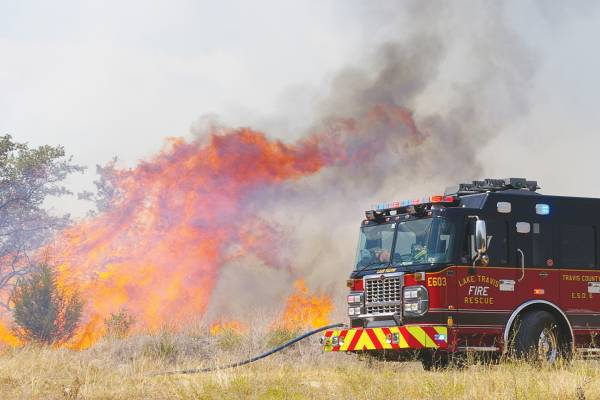
LTFR fire suppression services are delivered by three 24/48-hour working shifts working from six stations. Photo by LTFR
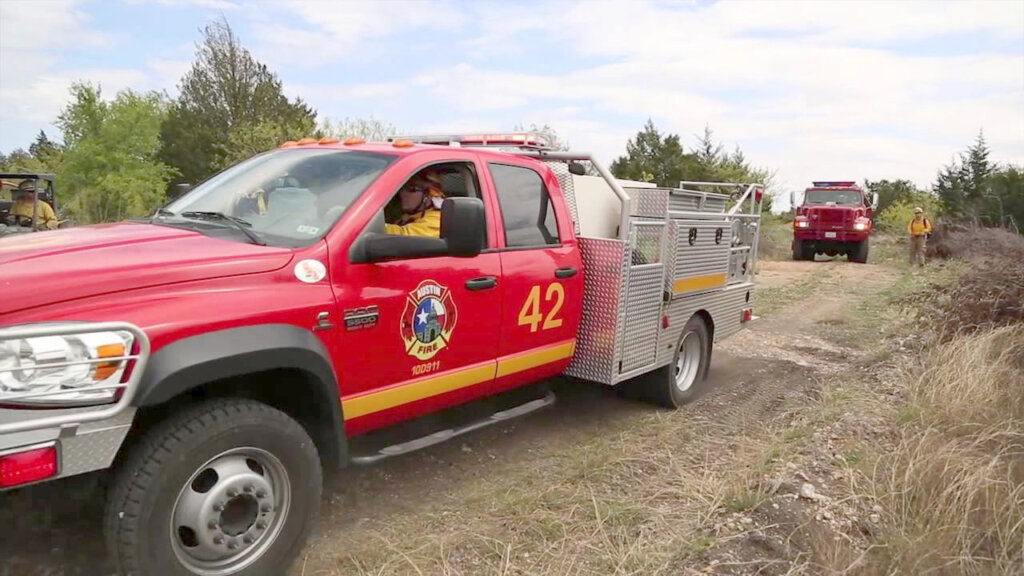
By JOHN D. BOYLE, Four Points News
With wildfire risks and activity intensifying nationwide, the Austin area is taking significant steps to protect its residents. The Four Points area in Northwest Austin, encompassing neighborhoods like Steiner Ranch, Canyon Creek, Grandview Hills, Volente and River Place, is no stranger to the threat of wildfires and other emergencies. The 2011 Steiner Ranch wildfire served as a stark reminder of the importance of preparedness and collaboration.
Lessons Learned from the 2011 Steiner Ranch Wildfire
The 2011 Steiner Ranch Fire serves as a grim reminder of wildfire dangers in Austin’s urban-wildland interface. That fire devastated Steiner Ranch, destroying 23 homes and forcing the evacuation of 1,000 residents. The fire, caused by arcing electrical lines, highlighted vulnerabilities in emergency response and community preparedness. Key lessons include:
- Timely Communication: The establishment of Warn Central Texas, an emergency notification system, ensures residents receive real-time alerts via text, email, or phone.
- Collaborative Response: The Austin/Travis County Fire Automatic Aid Agreement enables the closest fire units to respond regardless of jurisdiction.
- Fuel Mitigation: Programs to reduce vegetation in environmentally sensitive areas have become a priority, adhering to U.S. Fish and Wildlife standards.
- Community Education: Initiatives like the Firewise program and structural ignition zone assessments help homeowners and HOAs make properties more defensible.
The Bastrop Complex Fire, occurring simultaneously, further stretched regional resources. “Back then, we didn’t have the coordinated resources we do now,” said Rachel Neutzler, Communications Director for Lake Travis Fire Rescue (LTFR). “We had to call for reinforcements from Plano and Dallas, which took hours to arrive.”
The Four Points community now benefits from a robust partnership between Austin Fire Department (AFD) and Lake Travis Fire Rescue (LTFR), supported by automatic aid agreements that ensure the closest resources respond, regardless of who has jurisdiction.
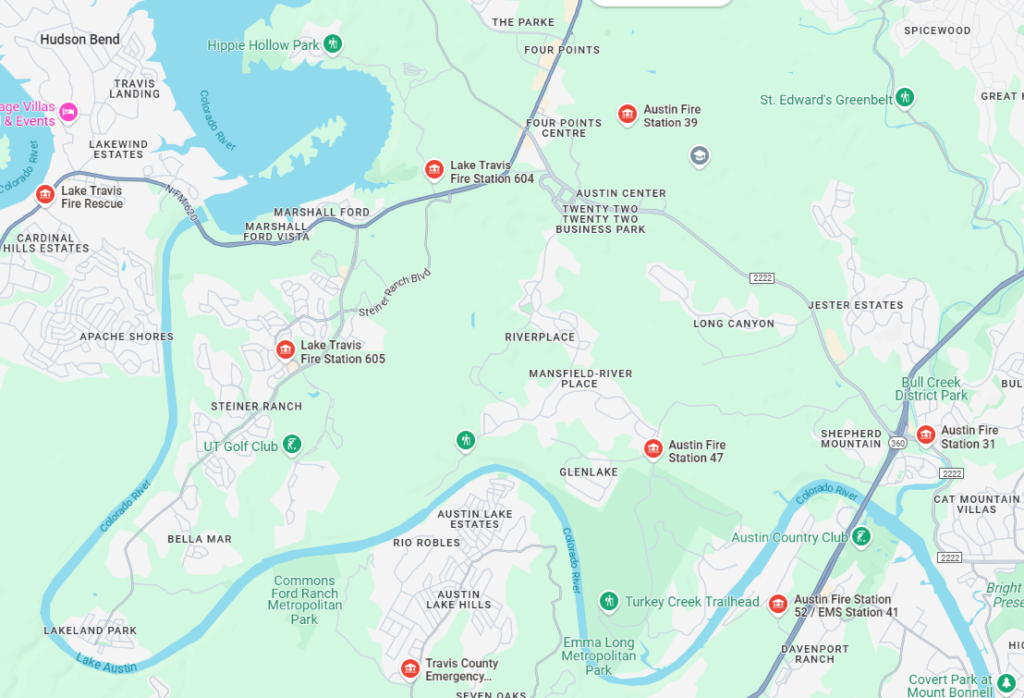
Strengthening Emergency Response
The new Fire and EMS Station 54, located off RM 620 in Canyon Creek, symbolizes a larger commitment to addressing the region’s wildfire risks and the community is better equipped than ever to respond to emergencies. “We’ve worked hard to reduce response times and improve wildfire training. These new stations are designed to meet the national response time standards of eight minutes for 90% of calls,” said Thayer Smith, Assistant Chief for Austin Fire. “With the growth in this area, the Canyon Creek station is critical to maintaining safety and mitigating risks.”
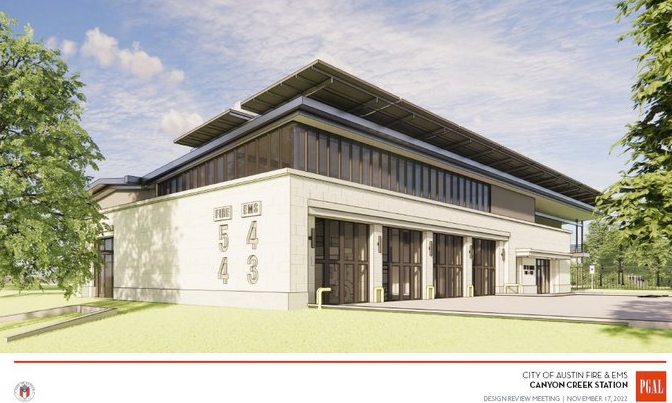
Station 54 is the fifth and final facility in a six-year initiative by the Austin City Council to improve emergency services in underserved areas. It joins AFD’s Wildfire Battalion, which consists of eight strategically placed stations equipped with specialized training and tools to combat wildfires and firefighters stationed here are part of the Wildfire Battalion, a team trained specifically in wildfire mitigation and response. The station features a new engine and brush truck designed to handle rugged terrain and off-road emergencies, dormitories, a gym, and a walking trail that doubles as a training area for wildfire preparedness. “Our wildfire battalion is critical in areas like Canyon Creek,” said Smith. “With the growth of the city, these stations are vital to reducing risks and meeting increasing demand.” The new station also collaborates with nearby facilities, including Station 39 and LTFR’s Station 605 in Steiner Ranch. Such partnerships are essential in areas where multiple jurisdictions overlap. “It doesn’t matter what color the truck is or what name is on it,” said Neutzler. “When an emergency happens, the closest unit responds. That’s how we ensure the fastest help possible.”
While the station officially began operations on January 10, 2025, a grand opening is planned for early Spring, offering the community a chance to tour the facility and meet first responders. But this milestone is part of a much larger conversation about fire prevention and emergency preparedness and prevention in Austin.
The Role of Local Leadership
Mark Duchen, recently elected to represent District 10 on Austin’s City Council, campaigned on wildfire prevention and is pushing for expanded efforts in Austin. “The city has tackled a lot of low-hanging fruit, but there’s more to be done,” he said. “Fuel mitigation, evacuation planning, and updated building codes are all critical. But we also need community engagement to make these initiatives successful.” One of the challenges, Duchen noted, is balancing environmental preservation with fire prevention. ““We must figure out how to galvanize people around this issue,” said Duchen. “This is not just about the fire departments taking action, but rather every one of us doing our part to proactively reduce wildfire risks. Greenbelts are part of what makes Austin special, but they also pose fire risks. We need to find a balance that protects both people and nature.”
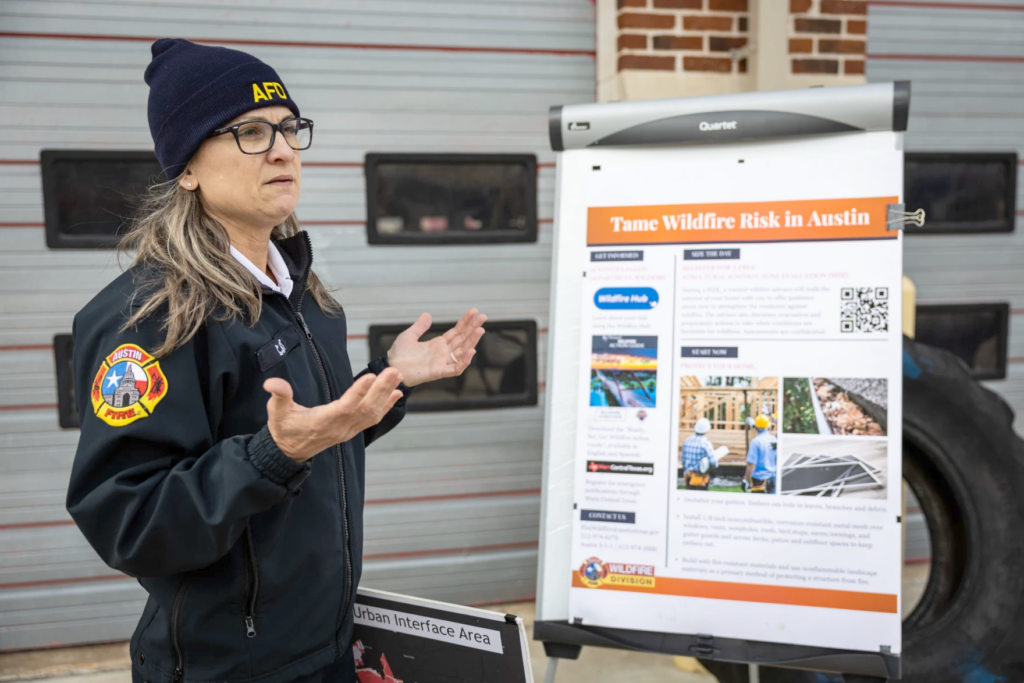
Emergency Evacuations: What You Need to Know
During any fire, seconds can mean the difference between life and death. First responders stress the importance of following evacuation orders immediately. “Once an evacuation order is given, you have to act and follow all instructions,” said Smith. “Delaying evacuation to gather non-essential belongings puts you and others at risk. Remember, your life is more valuable than your belongings. Things are replaceable, you and your family are not!”
However, some residents make dangerous mistakes during evacuations. During previous wildfires, some attempted to prematurely re-enter evacuated areas, often using bicycles or drones to assess damage. This was an issue during the 2011 Steiner Ranch fire. “Entering an active evacuation zone is dangerous and disrupts our operations,” Smith said. “Drones pose a significant risk to firefighting airplanes, helicopters and our own drones. If a drone collides with one of our aircraft, it could put emergency crews, equipment and our entire operation in jeopardy. As soon as an evacuation order is in place, ground your drones.”
Neutzler echoed this sentiment and stressed that residents must wait for official clearance before returning to evacuated areas. “This is a lesson we’ve seen repeatedly, from Austin to the wildfires in California,” she reflected. “Uncoordinated attempts to help or gather information are more of a hindrance than help. We need our community to focus on the ‘we’ in these situations not the ‘me.’”
Council member Duchen expressed strong support for potentially increasing criminal and civil penalties for individuals flying drones during active evacuations. He described the action of flying drones in these critical situations as dangerous and disruptive, pointing out that it puts firefighters at risk and compromises operational effectiveness. “I think the county and the city should really discuss a stiff penalty for flying personal drones during evacuations, “said Duchen.
Building a Culture of Emergency Preparedness
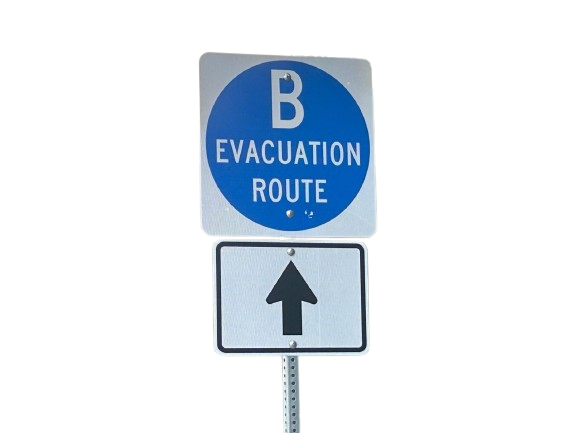
“Wildfires spread quickly,” Smith said. “The time to act is not during an emergency but in advance through preparation and risk reduction. Once an evacuation order is given, you have seconds to act,” he emphasized. “Delaying evacuation to gather non-essential belongings puts you and others at risk. Residents and HOAs can proactively request structural ignition zone hazard assessments,” Smith noted. “Our wildfire division works closely with communities to identify risks and implement solutions.”
Both AFD and LTFR are working to create a culture of preparedness in the community. From National Night Out events to neighborhood cleanup days, these departments are engaging residents in fire safety conversations. “Preparedness isn’t just about homeowners,” said Neutzler. “It’s about entire communities coming together and working proactively. Know your neighbors, check on each other, and work as a team.” Neutzler added that small acts can make a big difference. “Carpool during evacuations to reduce congestion. Help neighbors who may need assistance. It’s not just about protecting your own home—it’s about looking out for everyone.”
Addressing Manpower and Recruitment
Currently, the Austin Fire Department is authorized for 1,303 personnel but has approximately 70 vacancies. “We recently started a new cadet class of 48,” Smith explained. “These recruits will help fill many of our gaps. We’re working to meet demand and ensure we have the staffing necessary to keep our community safe.”
The department’s ongoing recruitment efforts include plans for additional training classes later in the year, ensuring that the AFD remains robust in the face of increasing demand.
Effective Fuel Mitigation Approaches: Goat Herds and Fire Breaks
A novel partnership between Lake Travis Fire Rescue and the Steiner Ranch HOA has introduced an innovative approach to fuel mitigation—a goat herd pilot program. The program utilizes goats to clear overgrown vegetation and brush in hard-to-reach areas, reducing fire risks while preserving the natural ecosystem.
“Goats are incredibly effective at clearing dense vegetation, and they can access steep or rugged terrain that’s difficult for our crews,” Neutzler said. “This program not only helps with wildfire prevention but also aligns with environmentally friendly practices.”
The pilot program has already shown promise, with plans to expand if it continues to yield positive results. Residents have praised the initiative as a creative and sustainable solution to a persistent challenge.
LTFR’s Wildfire Fuels Mitigation Crew has played a pivotal role in creating shaded fuel breaks around residential properties. These fuel breaks, designed to reduce the intensity of wildfires, involve trimming tree branches up to six feet off the ground, removing ladder fuels, and clearing underbrush.Neutzler noted the program’s measurable impact: “To date, we’ve mitigated over 180 acres, directly impacting thousands of homes and protecting an estimated $400 million in property value.”
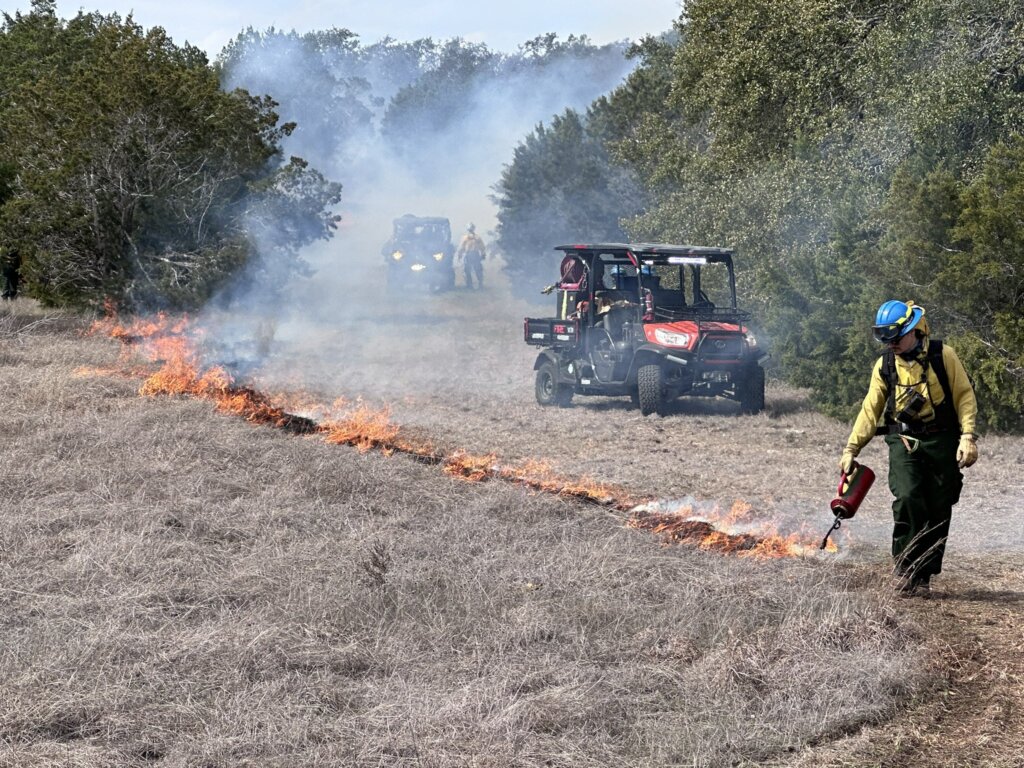
Community Involvement: Prevention Starts at Home!
Wildfires in Central Texas are fueled by dry weather, dense vegetation, and rapid wind shifts. Embers, the leading cause of home ignitions during wildfires, can travel miles and ignite structures far from the fire’s source. According to the Insurance Institute for Business & Home Safety, homes with proper mitigation measures nearly double their survival rate during wildfires.
Both AFD and LTFR emphasize that residents have a key role in fire prevention. The departments recommend clearing the “zero to five feet” zone around homes, removing combustible materials like woodpiles, dry brush, and flammable fences. Neutzler noted that this lesson came directly from the 2011 Steiner Ranch Fire. “Our crews were cutting decks and fences away from houses to stop fires from spreading,” she said. “Clearing that zone is one of the most effective ways to protect your home.”
First Critical Step for All Residents
Schedule a home fire risk evaluation before Spring and address identified risk factors before Summer. Both the Austin Fire Department (AFD) and Lake Travis Fire Rescue (LTFR) offer free evaluations to help you identify vulnerabilities in your home and mitigate fire risks. You can book an evaluation via LTFR’s website or by emailing their wildfire division at wildfire@ltfr.org.
Proactive Steps for Homeowners and Landlords
- Create a Defensible Space:
- Maintain a 5-foot noncombustible perimeter around your home (no mulch, flammable plants, or firewood stacks).
- Trim tree limbs up to 6 feet off the ground and remove dead vegetation within 30 feet.
- Clean gutters and remove dry branches and leaves.
- Harden Your Home:
- Install ember-resistant vents and cover gutters with noncombustible materials.
- Upgrade to fire-rated roofing and siding materials.
- Replace wooden fences connected to your home with noncombustible fencing.
- Prepare an Emergency Kit:
- Include important documents, medications, clothing, and food supplies. Store scanned copies of critical documents in the cloud.
Proactive Steps for Multi-Tenant Residents
- Clear Balconies: Remove flammable items like furniture, grills, plastic toys, blankets or plants from balconies.
- Maintain Exits: Ensure hallways, stairways, and exit doors are unobstructed and functional. Keep fire extinguishers near these exits to aid in safe exits in the event flames are blocking your escape.
- Know Your Building’s Plan:
- Familiarize yourself with your building’s evacuation plan.
- Know the location of fire extinguishers and alarms.
- Communicate: Collaborate with neighbors and property management to address potential fire hazards.
Community Efforts: Working Together for Safety
Fire prevention and safety are not solo endeavors. Communities can:
- Join the Firewise USA Program: Work with neighbors and create fire-resistant landscapes and that meet current national standards.
- Sign Up for Emergency Alerts: Use Warn Central Texas to receive real-time updates during emergencies. https://warncentraltexas.org
- Volunteer for Cleanup Days: Assist in community efforts to remove brush, dead vegetation, and other fire hazards.
- Advocate for Emergency Access Routes: Identify and maintain evacuation routes. In Steiner Ranch, for example, emergency access roads are a critical safety feature during evacuations. During an evacuation the fire departments are responsible for opening these evacuation routes.
Know and Follow Evacuation Plans
When an evacuation order is issued:
- Leave Immediately: Gather only essential items and ensure all family members, including pets, are accounted for and safe. Follow all the instructions. Work together!
- Avoid Congestion: Use designated evacuation routes and avoid unauthorized re-entry. Take one vehicle with only critical items you have prepared proactively.
- Ground Drones: Unauthorized drone use can disrupt aerial and ground firefighting operations and endanger lives.
Conclusion: Fire Safety Starts with You
Preparedness is the most effective way to reduce fire risk. Whether by scheduling a fire risk evaluation, hardening your home, or working with your community, every step you take contributes to a safer Central Texas. Protecting your home and loved ones begins with proactive action—don’t wait until it’s too late.
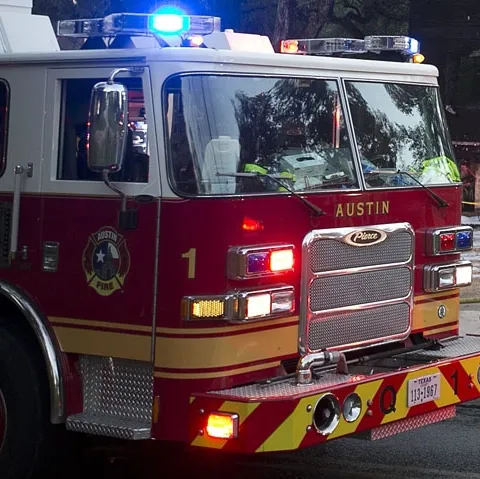
Looking Ahead
Station 54’s opening is a significant step forward, but it’s just one piece of the puzzle. As Austin continues to grow, so too does the need for proactive fire prevention and emergency preparedness. “Wildfires are unpredictable, but preparation isn’t,” said Smith. “By working together, we can reduce risks and ensure the safety of our community.”
Preparedness is the most effective way to reduce fire risk. Whether by scheduling a fire risk evaluation, hardening your home, or working with your community, every step you take contributes to a safer Central Texas. Protecting your home and loved ones begins with proactive action—don’t wait until it’s too late.Together, we can (and must) build a safer, more resilient future for Austin.
For more resources, visit AFD’s Wildfire Hub or contact LTFR for a Structural Ignition Zone Hazard Assessment.

